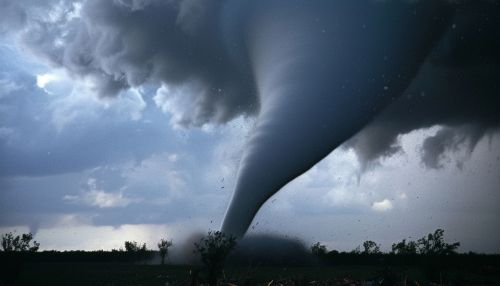Tornado intensity: Difference between revisions
(Created page with "== Overview == A tornado is a rapidly rotating column of air that is in contact with both the surface of the Earth and a cumulonimbus cloud or, in rare cases, the base of a cumulus cloud. The intensity of a tornado is primarily measured by the EF scale, which takes into account the damage caused by the tornado to human-built structures and vegetation. <div class='only_on_desktop image-preview'><div class='image-preview-loader'></div></div>...") |
No edit summary |
||
| (One intermediate revision by the same user not shown) | |||
| Line 2: | Line 2: | ||
A [[tornado]] is a rapidly rotating column of air that is in contact with both the surface of the Earth and a cumulonimbus cloud or, in rare cases, the base of a cumulus cloud. The intensity of a tornado is primarily measured by the [[Enhanced Fujita scale|EF scale]], which takes into account the damage caused by the tornado to human-built structures and vegetation. | A [[tornado]] is a rapidly rotating column of air that is in contact with both the surface of the Earth and a cumulonimbus cloud or, in rare cases, the base of a cumulus cloud. The intensity of a tornado is primarily measured by the [[Enhanced Fujita scale|EF scale]], which takes into account the damage caused by the tornado to human-built structures and vegetation. | ||
[[Image:Detail-77937.jpg|thumb|center|A tornado in progress, showing a large, funnel-shaped cloud touching the ground and causing destruction.|class=only_on_mobile]] | |||
[[Image:Detail-77938.jpg|thumb|center|A tornado in progress, showing a large, funnel-shaped cloud touching the ground and causing destruction.|class=only_on_desktop]] | |||
== Formation == | == Formation == | ||
Latest revision as of 13:05, 8 May 2024
Overview
A tornado is a rapidly rotating column of air that is in contact with both the surface of the Earth and a cumulonimbus cloud or, in rare cases, the base of a cumulus cloud. The intensity of a tornado is primarily measured by the EF scale, which takes into account the damage caused by the tornado to human-built structures and vegetation.


Formation
Tornadoes form in a variety of weather conditions, but they are most often associated with severe thunderstorms, particularly those known as supercells. These are thunderstorms with a persistently rotating updraft known as a mesocyclone. The combination of the updraft and ambient wind profiles leads to the development of a tornado vortex.
Intensity and the Enhanced Fujita Scale
The intensity of a tornado is measured using the Enhanced Fujita (EF) scale, which replaced the older Fujita (F) scale in some countries. The EF scale rates tornadoes from EF0, being the least severe, to EF5, being the most severe. The scale is based on the degree of damage caused to human-built structures and vegetation, with each level having specific damage indicators.
EF0 Intensity
EF0 tornadoes are the least intense on the EF scale, with wind speeds ranging from 65 to 85 mph. These tornadoes may cause light damage to structures and vegetation, such as broken branches or peeled roof shingles.
EF1 Intensity
EF1 tornadoes have wind speeds ranging from 86 to 110 mph. These tornadoes can cause moderate damage, including severely stripped roofs, overturned mobile homes, and moving cars pushed off the road.
EF2 Intensity
EF2 tornadoes have wind speeds ranging from 111 to 135 mph. These tornadoes can cause considerable damage, including roofs torn off well-constructed houses, large trees uprooted, and cars lifted off the ground.
EF3 Intensity
EF3 tornadoes have wind speeds ranging from 136 to 165 mph. These tornadoes can cause severe damage, including entire stories of well-constructed houses destroyed, significant damage to large buildings, and trains overturned.
EF4 Intensity
EF4 tornadoes have wind speeds ranging from 166 to 200 mph. These tornadoes can cause devastating damage, including well-constructed houses and whole frame houses completely leveled, cars thrown, and small debris becoming missiles.
EF5 Intensity
EF5 is the highest intensity on the EF scale, with wind speeds over 200 mph. These tornadoes can cause incredible damage, including strong frame houses leveled off foundations and swept away, automobile-sized missiles flying through the air in excess of 100 meters, and trees debarked.
Tornado Intensity and Climate Change
There is ongoing research into the link between climate change and tornado activity. Some studies suggest that while the overall number of tornadoes may not increase, the intensity of tornadoes could increase due to a warming climate. However, this area of research is complex and there is not yet a consensus among scientists.
